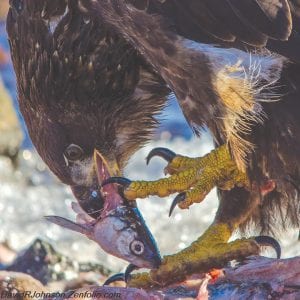Anglers who catch Kamloops trout might be interested to know that each “Looper” as some fishermen call them, cost $160 per fish to produce.
Which is too much, said the Minnesota Department of Natural Resources (DNR) ,who last week announced it is closing the 1970’s era French River Cold Water Hatchery in Duluth.
The DNR is closing the aging Duluth hatchery, which is the home of the Kamloops stocking program for Lake Superior because the facility needs $8 million in infrastructure upgrades and it consumes 10 percent of all energy used by the DNR statewide.
Kamloops trout are a domesticated strain of rainbow trout that cannot reproduce in Lake Superior naturally. North Shore anglers fish from shore at the mouth of Cascade River and other North Shore rivers for Kamloops because they area a beautiful, active sports fish that put up a good fight. The limit is three per angler and the fish weigh on average from 2-5 pounds but can weigh up to 10 pounds.
The French River Cold Water Hatchery (FRCWH) was first used to restock Lake Superior with lake trout. When the lake trout made a healthy recovery, the hatchery was used to raise steelhead trout, which now have a self-supporting wild population.
Fisheries Chief Don Pereira said energy inefficiency and costly repairs make it necessary to close the hatchery, but the remaining fish production from French River will be continued elsewhere.
“We remain firmly committed to providing great fishing opportunities in Lake Superior and along the North Shore,” Pereira said. “To provide the best fishing we can for anglers, we need to be strategic about how we use energy, and we’re confident we can adjust to meet angler needs with our remaining four hatcheries.”
Pereira said production of Kamloops trout, which are raised at French River and stocked in Lake Superior, would be moved to another hatchery.
“Kamloops provide a popular near-shore fishery for Lake Superior anglers,” Pereira said. “We will continue to produce Kamloops at another nearby hatchery until an agreed-upon strategy is reached with the Lake Superior Advisory Group, a group of anglers who work with the DNR on Lake Superior issues.”
Under current French River operations, each Kamloops an angler keeps costs approximately $160 to produce. The hatchery is inefficient because it uses Lake Superior’s cold water and must heat the water to a temperature at which fish can be raised, a process that is less costly elsewhere.
Despite the cost to produce the fish, Kamloops Advocates is asking to find a way to keep the French River Hatchery open. They are urging anglers and businesses benefitting from the FRCWH programs to contact Minnesota State Senator Tom Bakk (DFL) asking him to seek bonding, increased license fees, and General Fund Revenue to keep the FRCWH and its Kamloops program open and operating.
“In the simplest analysis, the French River Cold Water Hatchery generates 4 percent Kamloops returns while Spire Valley Hatchery is predicted to yield only 1 percent. This means Kamloops returns will drop from around several thousand to only 900 (at best) with the Spire Valley Hatchery. Kamloops production for an effective Lake Superior planting program needs to be returned solely to the French River Cold Water Hatchery,” the group states.
The French River Hatchery was built in the 1970s to aid in the restoration of lake trout in Lake Superior, which at the time depended heavily on stocked fish. Today, wild lake trout have staged a healthy recovery in Lake Superior, which means the agency no longer needs to stock the fish in the big lake.



Leave a Reply